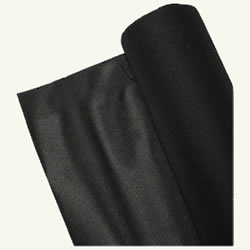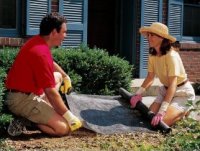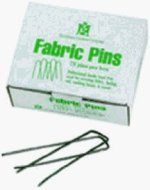Choosing the correct landscape fabric (geotextile), Figure 1, for weed control can be a very time consuming and frustrating exercise, as anyone who has gone through the process will gladly confirm.

Figure 1 - Landscape fabric (geotextile)
The manufacturers of landscaping fabrics produce and publish specifications; however the major problem is that their largest market is the construction industry. Hence, they produce their specifications with the construction market in mind. If you have an unlimited amount of time and a lot of patients you can read through all of the manufacturers’ specifications and try to garner some useful comparison information that will be useful in weed control and prevention.
When choosing a fabric for landscaping, there are three primary areas to consider:
- The strength of the fabric is relative to the amount of air and water flow that will permeate through the fabric. Stronger materials allow less water and air to flow through the fabric.
- You want to choose a fabric that has a consistent and even dispersal of fibers. The mesh size should be as small as possible in order to prevent weedy grasses from penetrating the fabric’s openings. Weeds and grasses do not grow through the fabric they are attracted by any minute quantities of light that may penetrate the openings between the weave in the fabric or in separations that have occurred between pieces of fabric.
- There is a fine balancing act with respect to the porosity of the landscaping fabric. You want the mesh to be fine enough to prevent weed and grass growth but you want the holes in the mesh to be large enough to provide sufficient water and air to enter the soil. The fabric’s ability to breath; to allow oxygen and moisture to pass through the fabric and aerate and water the soil so that the plants will be hardy and not starved of essential life sustaining material. It is this feature that separates the average landscaping fabrics from the superior ones. This is why the use of plastic sheeting as a weed deterrent does not work. It may prevent the growth of weeds and grasses but it also prevents air and water from entering the soil. A fabric that does not have good permeability will create the problem of water run off which will wash away any coverings such as bark or mulch that may be lying on the surface of the fabric.
When choosing a fabric for your landscaping project you should identify one that has adequate strength for the application, any additional strength is counter productive and will cost you more.
Weeds can germinate in the smallest amount of soil and hence will grow on top of the fabric, if there are the tiniest amounts of earth, sending fine root hairs through the fabrics weave on a quest for nutrients and moisture from the soil. To prevent weed and grass growth appearing through the fiber’s weave consider the use of a spunbonded fabric because of its microscopic mesh size.
The earlier materials were made of woven fibers and are still available today, however technology has advanced the manufacture of landscaping fabrics and nonwoven fabrics are now available. Nonwoven landscape fabrics do not provide and holes where weeds may grow and are generally considered to be the product to use.
The weight of the fabric usually determines its life. Most manufacturer's offer a guarantee and that can range from 1 year to life time and everything in between. Weights vary from less than 2 ounces to 5 ounces.
Installing landscape fabric in plant beds
The installation of landscape fabric is not difficult, however, many homeowners do not take the time to prepare the soil bed properly before they lay the fabric in position. As well, a common error is to place tree bark, gravel or mulch on top of the fabric thinking that these materials alone, will hold the landscape fabric in place.
- Proper soil bed preparation:
- Unroll the fabric:
- Secure the fabric:
- Coverings:
The soil bed must be prepared before the fabric is laid. Any remnants of grass roots, weeds or plants that you no longer desire in that bed must be removed. The landscape fabric is designed to allow plant growth, it will not prevent plants that are in the bed from growing!
Use a fan rake to level and smooth the surface of the bed. Remove any stones, as they will eventually cut through the fabric and leave a spot for weeds to take hold.
Unroll the landscaping fabric, as shown in Figure 2, and cut notches to place the fabric around trees, shrubs and other plants.

Figure 2 - Landscape fabric being unrolled.
Make sure the fabric comfortably closes around the back of the tree, shrub or plant. This may require that the original notch be expanded by cutting spokes out from the base of the notch, to allow the fabric to encompass the plant.
The landscaping fabric needs to be mechanically held down at a maximum of every 5 feet along the perimeter.
Manufactures make pins or staples (Figure 3) and pegs (Figure 4) specifically to secure the landscaping fabric to the soil beds.

Figure 3 - Landscape fabric pins or staples

Figure 4 - Landscape fabric pegs
Without the use of pins, staples or pegs the landscape fabric will creep away from the edges of the planting bed and separate where fabric sheets meet.
Most manufacturers recommend that the landscaping fabric be covered with a material such as tree bark, mulch or stone.
Be gentle when adding materials to the top of the landscape fabric. It is very easy to rip through the landscape fabric with the tines from a garden rake.
